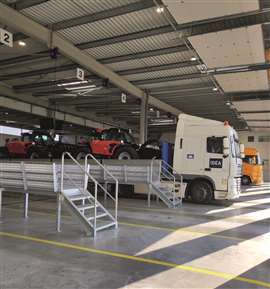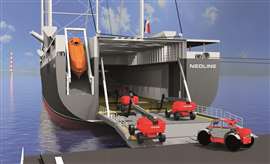Transport for access - a 360 degree report
19 October 2023
AI spoke to three major organisations in the manufacturing, rental and association spheres – namely Manitou, Kranpunkten and IPAF, to find out what makes the market tick in terms of transport, with a special focus on safety and the environment.
MANUFACTURING
Safety and efficiency have always been generic terms associated with effective transportation of MEWPs. In recent years they have been joined by another vital element, that of the environment and how to juggle the needs of the customer with rapidly expanding policies around sustainability.
Manitou is a specialist in telehandlers and MEWPs, having rapidly expanded its self-propelled boom range in recent years and acquired the itnellectual rights to France-based vertical mast pioneer ATN Platforms last year.
 Mantou’s loading dock faclity in Acenis
Mantou’s loading dock faclity in Acenis
Hence the manufacturer has plenty of experience in the day-to-day trials and tribulations of moving the equipment around the world to its customer base.
As Fanny Sourisseau, global marketing product manager - MEWP, points out one of the greatest challenges is around safety, as the equipment is loaded and unloaded.
For example, says Sourisseau, a truck colliding with a MEWP that is being unloaded from another truck at the side of the road. “This accident highlights the lack of visibility of an aerial platform in its working environment,” says Sourisseau, “But that’s not all. We know that the securing of a MEWP is the cause of many falls by the carrier, often resulting in work stoppages.”
The height of aerial platforms in truck transport configuration is another issue, which has to be taken into consideration in the equipment design phase. The company has to ensure products can pass under bridges, with a total height of 4m. “It’s a major source of concern for us as manufacturers,” says Sourisseau.
“It’s vital that we work together to ensure that we meet our customers’ day-to-day challenges,” says Sourisseau.
Lighting the way
For example, through customer feedback, Manitou launched the Pack Lighting system that is attached around the machine’s chassis and basket, providing better visibility for the operator when loading the platform onto the truck, and better visibility in the basket.
Franck Lethorey, external communicates manager for Manitou, adds “Since the launch of our telescopic boom models, we also offer a wired remote control as standard on the machine, which facilitates the folding of the aerial platform structure, thus avoiding the need for the operator to balance on the trailer to carry out the folding movements.”
In certain areas, customers may have to unload machines at certain times of the day to avoid noise pollution, particularly for local residents. This is a challenge to which Manitou has responded by offering 100% electric all-terrain aerial platforms in its range.
Zero emissions
 The Neoline
The Neoline
The next stage is a zero-emission delivery truck. While Swedish rental company Kranpunkten, included in this feature, has already launched a compact version, the challenge is to provide a much larger unit.
“We are in discussions with carriers about the use of green hydrogen trucks for parts transport.”
In addition to that, says Lethorey, “The current implementation of our action plan, based on a journey-by-trip analysis of our flows, should enable us to help our hauliers make the right decisions in terms of biofuel choices. It’s a global approach that doesn’t just depend on Manitou Group’s business.”
The company has recently opened a new 8-dock loading dock facility in its home town of Ancenis to absorb the increasing demand around effective transport logistics.
“These new installations meet a need for safety on the site where more than 50 machines are dispatched daily.
Lethorey adds, “We have also optimised flow management, with carriers on their own circuit, so there is no need to cross paths with pedestrians or forklift drivers on a site where flows are more and more dense.”
The location offers an enclosed area around the dock to avoid exposure to harsh weather conditions.
Sailing ahead
On the subject of cross Atlantic transport, Manitou’s arrangement with Neoline is another step down the line. In 2020 the manufacturer made official its partnership with the eco-friendly sea transport company for its deliveries to North America.
It will see all Manitou’s aerial platforms despatched from France to North American, primarily using sail ships.
The expectation is to ship more than 1,500 machines a year by the summer of 2025, when the St-Nazaire to Baltimore shipping line opens.
“We have a strong commitment to reduce our CO2 footprint by 2030, and the impact of our maritime freight is one of the indicators that we are working on.
“To give you a concrete figure, crossing the Atlantic Ocean thanks to the Neoliner, the name of the boat, will allow us to reduce CO2 emissions by 90%, compared to a ‘classic’ cargo that uses only thermic energy.
Lethorey adds, “We are also seeking to prioritise land transport over air to reduce costs in line with our low carbon trajectory validated by SBTi, with the goal of reducing our freight-related emissions by 15% by switching from air to land transport.”
|
RENTAL One of the most developed regions when it comes to new techniques and the adoption of zero emission initiatives is the Nordics. Based in Sweden, Kranpunten has already taken the ultimate step of co-designing its own 100% electric MEWP delivery truck.  Kranpunkten’s electric truck. Kranpunkten’s electric truck.
Usually, transport of machines to and from customers’ work sites is primarily carried out in collaboration with logistics partners. The transports are ordered by Kranpunkten’s logistics planners, after which the transporters optimise their vehicles. In this case, the electric truck is a joint effort between Kranpunkten, logistics partner Swerock and Volvo Trucks. The truck operates in the inner city of Gothenburg and is based at one of Kranpunkten’s depots in the area, where it’s charged with renewable electricity from the company’s own solar power installation. According to Kranpunkten, the electric truck is proving to be a win-win for the company and its customers. “It performs very well, being quiet and comfortable for both drivers and those around the vehicle during loading/unloading. “Our customers also appreciate these transports for their environmental impact and their ability to showcase their forward-thinking by choosing this type of transport.” New philosophy Other transport vehicles provided by Kranpunten’s logistics partners consist of trucks with specialized flatbeds for machine transport and specially built crane trucks, for which the rental company specifies HVO100, to the greatest extent possible. Currently, HVO100 constitutes 54% of the fuel used for the company’s transportation. In terms of transportation, “our ambition is to expand with more electric trucks in the future. The goal is that all our regions will be able to offer customers this transport solution.” This philosophy falls in line with the company’s expanding aerial platform fleet. “We have made significant investments in the last two years in terms of new, climate-smart machines, expanding the rental fleet by 15%. We will continue to invest in this area.” Presently, 85% of the company’s machines are electric or hybrid-powered. Hydrogen, in combination with HVO fuel, has been discussed among Kranpunkten’s logistics partners, as an alternative where electric power isn’t feasible, such as long transport distances. Indeed, one of the main challenges for rental companies, when it comes to road transport for access, now revolves around emissions. “Moving machines between depots and work sites in collaboration with logistics partners is part of our business model, but it’s also where our environmental impact is most significant,” says the company. “As a leading player in our industry, we have a significant responsibility to drive sustainability development throughout the chain. We maintain a continuous dialogue with our logistics partners, aiming to influence them in a more environmentally friendly direction.” Kranpunkten has set a target for 80% of its transports to be carried using HVO100 as fuel. In 2022, 54% of transports were conducted using alternative fuels. “Factors such as fuel availability and pricing have prevented us from reaching the goal yet.” A challenge with the electric truck is that it doesn’t have a fixed route. This places high demands on logistics planning to maximise battery range. Precise locations The company is continuing to optimise transportation. One of the initiatives is through consolidating where possible and ensuring trucks are appropriately sized for both environmental and economic gains. Under the company’s Functional Pools concept, small depots are established at major work sites, where rental and machine service is handled on-site, significantly reducing the need for transportation. Out of Kranpunkten’s fleet of 4,500 machines, 3,400 have been equipped with GPS. This provides precise location information for each unit and enhances logistics planning and on-site machine work efficiency. Through a mobile app, the company has also enabled service and maintenance to be conducted at customers’ sites, avoiding the need to transport machines back to its depots each time. Indeed, looking back over recent years, the issues that have arisen through the Covid pandemic, for example, are outweighed when it comes to transport and the growth of the electric MEWPs across Europe. “The pandemic hasn’t affected us. Infrastructure expansion for electric vehicles has a much more significant impact.” AI |
ASSOCIATION PERSPECTIVE
When it comes to accident data, International Powered Access Federation (IPAF) is leading the way in terms of establishing the main causes of injures and deaths directly related to the access industry.
A majority of its data has been gleaned from the UK, however there has been an expansion of participants more globally, and that is expected to grow.
Nevertheless, the numbers represent an important insight into the where the greatest dangers lie in a mature access rental market, such as the UK.
For those who have not yet studied the data, it illuminates what might be a surprising outcome for some, in that while there are plenty of risk areas for MEWP operators, statistically it is the delivery truck driver who is at the greatest risk during loading or unloading, or from slips or falls on the flatbed of the truck.
Most of these accidents occur in rental yards themselves, while the unloading and loading operations take place. That is followed by accidents on construction sites.
Brian Parker, Head of Safety and Technical at IPAF, who has longstanding experience in the rental sector, says the delivery driver is often placed under considerable pressure.“The driver is human and has feelings. I have seen some drivers; great drivers that will go to the end of the Earth to get that last load out. They can be put under a huge amount of pressure by a hire desk, which is also under pressure to take orders.”
Drivers as risk
With experienced and skilled labour increasingly hard to come by, the delivery of equipment is a crucial link in the system that is at risk of being overlooked. Between 1 January 2013 and 31 July 2023, IPAF’s Accident Portal showed there were 943 reports of accidents relating to the role of delivery driver. The reports came from 19 countries, although 91% of the reports were from the UK, and tragically there were 11 fatalities among those reports.
Just over 60% of the total number of these ‘delivery driver’ accidents occurred during in a rental activity, such as loading or working in a rental yard, while almost 30% occurred on a construction site. In over 32% of the incidents there was no machine involved, which demonstrates the day-to-day dangers of working on the back of a truck before the equipment is loaded on or after it has been unloaded.
This is supported by the data, including lost time incidents relating to delivery drivers. Slips, trips and falls from the same level is by far the biggest casue of major or minor injuries. While there are no fatalities related to this incident category, a major injury can be life changing and a minor incident at the very least leads to discomfort and lost time.
So, it seems a delivery driver, working on a flatbed truck in the rental yard is in the most in danger of injury across the access industry, even in a mature, heavily regulated access market such as the UK.
The greatest cause of fatalities for delivery drivers is on the road. This is why IPAF launched we launched Safe Use Of MEWPS in Public Areas and Loading and Unloading. The level of training from those entering accidents on the database was not requested by the portal until 2018, when it was introduced by IPAF’s Accident Working Group and International Safety Community in a bid to directly assess the impact of the Federation’s safety awareness campaigns.
As Parker points out, if we look at the last five years, there are 449 incidents in 16 countries and eight fatalities - eight in the last five years and 211 in the last 10 years – it means, says Parker, “We are getting better at capturing data outside the UK.”
For more about the portal visit: www.ipafaccidentreporting.org/dashboard
STAY CONNECTED



Receive the information you need when you need it through our world-leading magazines, newsletters and daily briefings.
CONNECT WITH THE TEAM










